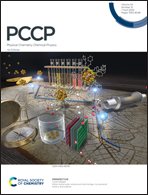Cyclo[18]carbon including zero-point motion: ground state, first singlet and triplet excitations, and hole transfer†
Abstract
Recent synthesis of cyclo[18]carbon has spurred increasing interest in carbon rings. We focus on a comparative inspection of ground and excited states, as well as of hole transfer properties of cumulenic and polyynic cyclo[18]carbon via Density Functional Theory (DFT), time-dependent DFT (TD-DFT) and real-time time-dependent DFT (RT-TDDFT). Zero-point vibrations are also accounted for, using a Monte Carlo sampling technique and a less exact, yet mode-resolved, quadratic approximation. The inclusion of zero-point vibrations leads to a red-shift on the HOMO–LUMO gap and the first singlet and triplet excitation energies of both conformations, correcting the values of the ‘static’ configurations by 9% to 24%. Next, we oxidize the molecule, creating a hole at one carbon atom. Hole transfer along polyynic cyclo[18]carbon is decreased in magnitude compared to its cumulenic counterpart and lacks the symmetric features the latter displays. Contributions by each mode to energy changes and hole transfer between diametrically opposed atoms vary, with specific bond-stretching modes being dominant.
![Graphical abstract: Cyclo[18]carbon including zero-point motion: ground state, first singlet and triplet excitations, and hole transfer](/en/Image/Get?imageInfo.ImageType=GA&imageInfo.ImageIdentifier.ManuscriptID=D2CP00343K&imageInfo.ImageIdentifier.Year=2022)


 Please wait while we load your content...
Please wait while we load your content...